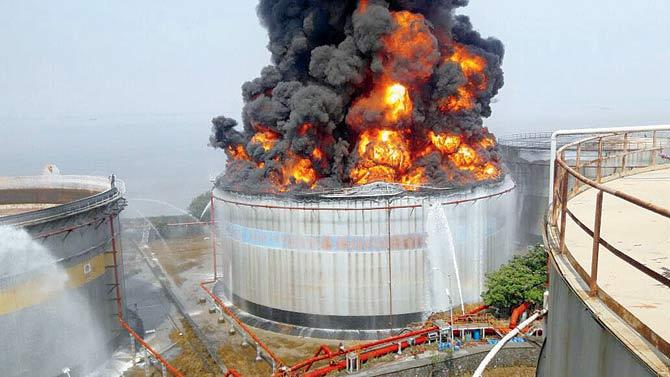Fire broke out in a tank of 32,000 metric tonne capacity, which was filled with high-speed diesel oil at the time of the incident

After firefighting for three days, teams of the fire brigade and Mumbai Port Trust (MbPT) managed to control the fire that broke out in tank number 13 of Bharat Petroleum Corporation Limited (BPCL) at Butcher Island on Friday evening. When the incident happened, the tank, which has a capacity of 32,000 metric tonnes, was filled to the brim with high-speed diesel oil. However, no one was injured in the incident.
ADVERTISEMENT

On the second day, the temperature of the tank had risen to 350° Celsius, making it difficult for the firefighters to go near it
Risk increases
On getting a call regarding the incident, the firefighters immediately rushed to the spot. As the flames were already out of control, they tried to bring down the temperature of the tank so that the fire did not spread to the other tanks located nearby. After an explosion occurred inside the tank around 11.45 am the following day, the risk of the other four oil tankers getting affected increased. Hence, the firefighters started spraying water on them as well. As a precautionary measure, BPCL officials decanted all the tanks.
Also read: Fire engulfs Butcher Island oil terminal off Mumbai
Sources said that tank number 16 was empty, while numbers 12 and 14 were decanted as soon as possible. Speaking to mid-day, P S Rahangdale, chief fire officer, said, "Firefighting was carried out with the help of three fixed monitors and two portable foam induction monitors. As a precautionary measure, we undertook cooling operations for tank number 14, 15, 16 and 12. There was great coordination between the fire brigade and MbPT."
Great coordination
He further said, "Usually in such situations there are high chances of damage to property and loss of lives. But our extensive efforts helped to keep the fire confined to tank number 13 and control it gradually. Our team along with the MbPT staff worked day and night to normalise the situation."
A senior fire official said, "On the second day, the temperature of the tank had risen to 350° Celsius, hence, we were not being able to go near it. On the third day, with the help of a thermal imaging camera we tried to understand the level of oil in the tank and the heat being generated by it. The use of high-tech personal protective equipment helped us to get closer to the tank."
Also view - Honeypreet Insan: From Ram Rahim's 'Angel' To Haryana's Most Wanted
 Subscribe today by clicking the link and stay updated with the latest news!" Click here!
Subscribe today by clicking the link and stay updated with the latest news!" Click here!






